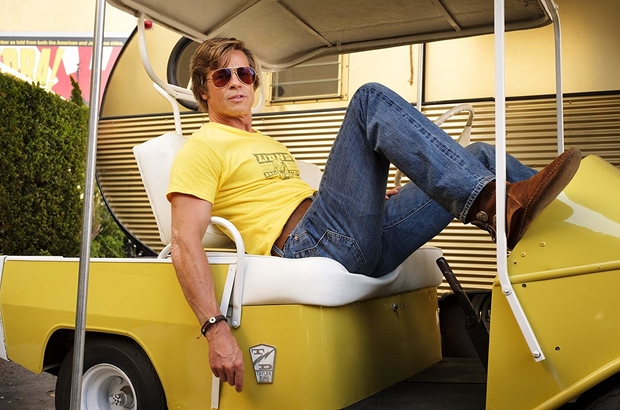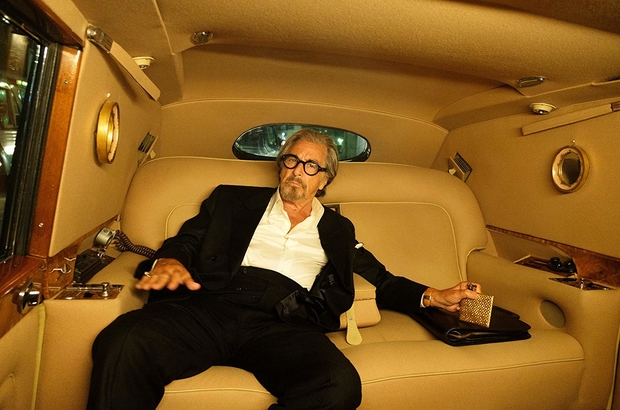SHANTI GIOVANNETTI-SINGH reviews Quentin Tarantino’s ninth film, Once Upon a Time… in Hollywood.
Lemon Cadillacs, wild-west stars and hippy cults replace pumpkin carriages, princesses and evil stepmothers in Tarantino’s ninth film, Once Upon a Time… in Hollywood. Following the lives of actor Rick Dalton (Leonardo DiCaprio) and his stunt double, Cliff Booth (Brad Pitt), as they approach the autumns of their careers, the film is an ode to Tarantino’s fantastical vision of Hollywood in the 1960s. This polychromatic masterpiece, fluctuating between sun-drenched yellow and piercing cerulean, showcases 160 minutes of seamless meandering into the lives of the real and fictional people who were responsible for the splendour, as well as the horror, that defined Hollywood as the swinging sixties drew to a close.

In Once Upon a Time we see the utter reversal of the signature Tarantino-esque ‘revenge-comedy’, despite it being, in many ways, the most appropriate of his films to be classified within this genre. Films such as Kill Bill (2003) and Inglorious Basterds (2009) are centred around a tale of revenge, the humour emerging through the sheer hyperbole of the violence. Through its utter absurdity, the torturous brutality loses its piercing reality. The cartoonish schadenfreude of Tarantino’s bloodshed is what compensates for the severity of the violence in so many of his films, providing comic relief as the audience witness eyeballs being pulled out, fountains of blood and the scalping of Nazis.
This is not the case in Once Upon A Time… In Hollywood. Recounting the real events which led to the murder of Sharon Tate and four others by the Manson Family cult, Tarantino uses his film to avenge the victims of one of Hollywood’s most sinister murders. The shockingly sparse moments of violence are unadulterated scenes of brutal torture. Observed through a suffocating film of obscurity, the horror of these instances are heightened by the nightmarishly graphic soundscape, created by Tarantino’s longstanding sound engineering team, headed by Mark Ulano and Wylie Stateman. The ‘real’ violence within the film’s sphere, is vividly contrasted with the absurd Tarantino-esque violence, mainly seen on screen in Dalton’s films or TV shows.
The humour, however, ranging from cheap laughs (for example the widely criticised portrayal of Bruce Lee as a stereotyped Asian Kung Fu Hollywood diva) to relentless caricatures, is markedly different from that of Tarantino’s established repertoire. Once Upon a Time… In Hollywood both silences and ridicules the members of the Manson Family. Their fanaticism ranges from blatant stupidity to inappropriate hypersexuality. This voracious sexuality is concentrated in Booth’s first visit to the ranch occupied by the Manson family. Some poignant examples include the underage Pussycat demanding to give Cliff Booth a blow job while he gives her a lift, as well as Squeaky (Dakota Fanning) warning him that she ‘Fucked [the] brains out’ of his elderly friend and ranch owner, George. Throughout the film, the Mansonites’ attempts at establishing a threatening aura are chipped away. Whether it’s by ridiculing their cult names or by revising historical truths (notably Cliff beating up the cult member at Spahn Ranch, when in reality it was the Mansonite who assaulted a stunt double) – their credibility vanishes.
More subtly, however, is the artistic revenge Tarantino takes upon the Manson family, by exhausting cinematic references to ridicule their attempts at being successful antagonists. Throughout the film, the overdone tropes of a horror film are played out … anticlimactically. The darkness, the sinister music, the mist transpires into a moment of humour or lightness. An evocative example is Booth’s visit to the ranch occupied by the cult. Trapped rats, wide empty stares and relentless warnings about going to check on George (who supposedly is ‘napping’), evolves into a comic exchange between a grumpy George (who really had been napping) and Booth. In many ways, this scene can be viewed as a microcosm of the film, where constant allusions to sinister events are often subverted or avoided.
This highly meta-cinematic film, described by Guardian columnist Peter Bradshaw as more than just ‘cinephilic erotica’, is unapologetically obsessed with the art of cinema. From its title, which is an allusion to the Sergio Leone film Once Upon A Time In The West, to the after credit scene, where Dalton advertises a brand of cigarettes exclusive to Tarantino’s franchise, the film is saturated with cinematic references. Throughout the film, we are bombarded with images of people watching people perform on screens. Beginning on the set of Bounty Law, we then see Dalton and Tate, in the various characters that they play, as both the main focus of scenes as well fleetingly in the background of noisy bars. From the drive-in cinemas to the television in Dalton’s swanky bachelor pad, to the grainy home television in the Manson cult and the Cinema where Tate watches herself indulgently, the screen is deeply etched into the tale. This democratising sphere, where everyone, no matter how different their personal or social background, watches the same program or film, utterly transfixed, is an exploration of the mesmerising enticement created by Hollywood. This sensation transcends the film and fixes itself upon the audience. Observing Tate and Dalton’s exhilaration whilst watching films and television unites not just the entire arena, but also the audience with the characters, continuing the recurring motif of blending the threshold between reality and fiction.
Particularly compelling is Tarantino’s reimagining of the fairy-tale Prince Charming through his startling portrayal of Rick Dalton. We see the multiplicity of his character, as he is dissected and watched from an ever-changing perspective. Introduced to us on set as the grinning star of the television series Bounty Law, DiCaprio’s character is almost unrecognisable later, bleary-eyed and stuttering, attempting to subdue the effects of his growing alcoholism. Later in his career, we see the very meta transformation, from the Hollywood heartthrob to a bloated, rough TV villain and spaghetti western star, who seems to increasingly resemble Jack Black. As a 1960’s wild-west star and Hollywood heartthrob, it would have been easy to model Rick Dalton using the stereotypes of toxic masculinity which are normally associated with such figures. Tarantino, however, rejects this cliché by creating a multi-dimensional character who swaps macho bravado with sensitivity. The fragility of his character is felt repeatedly through the range of tears we see him shed. From drunken howls caused by forgetting his lines to subtle sobs about the fate of Easy Breezy, the protagonist of his cowboy book, DiCaprio’s acting in this film can be seen as a study on the art of crying.
It cannot be denied that in an age where Hollywood’s dark side is at the forefront of media attention, it is unusual to produce a film which paints Hollywood in such a celebratory way. In light of the #Metoo movement, making the hero a man who has murdered his wife as well as completely ignoring to criticise Roman Polanski for his paedophilia is without doubt problematic. Moreover, the general premise of the film, which combines Tarantino’s sheer devotion towards a quasi-magical Hollywood with a real-life murder is at best insensitive and krass. But somehow, in Once Upon A Time… In Hollywood, Tarantino manages to pull it off. Whilst the issues raised are important to remember and continue to be wary of, what is equally important is the film’s startling end, where the end credits follow thick bold lettering, spelling ‘Once upon a time… In Hollywood’. The film is largely a fantastical reimagining of what Hollywood was, as well as what it could have been in a magical alternative reality. The unworldly coloured filters of this honey-drenched oeuvre literally cause the audience to perceive Hollywood through rose-tinted glasses. Whilst the problematic elements of this film must not be forgotten, it is important to view Tarantino’s ninth film as what is it, a fairy-tale. And like most fairy-tales, we must understand that whilst the story is magical and beautiful, the politics are often ugly.
‘Once Upon a Time… In Hollywood’ is on general release.
Featured image source: imdb.com





